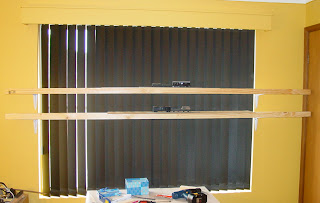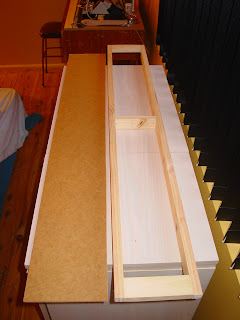


Being Thursday and the second last day of my days off work (where did the time go) I thought I'd better do something constructive otherwise I'd regret it once I got back to work next week.
I've been wanting to have a little test bench with some track and points for a while, and figured this is as good a project as any to do over the last few days of the holidays. It's a simple job, a piece of 1,200mm long laminated board, a pair of points, two parallel tracks and a few bits of wire. Sounds simple enough and should only take a couple of hours I figured.
Well, probably six or seven hours later and it's still not finished, but is at least working in a sense of the word. 3803 runs happily back and forth through the points and along both tracks, crossing over from one to the other without stalling, derailing or shorting out, which means that a. the track work of the points is to a reasonable standard, b. I got all of the isolating cuts in the pcb sleepers in the right spot, and c. I managed to wire up the point switches and feeder wires the correct way.
Except that is, for one set of feeders which I wired to the rails the wrong way around (they looked right when the track was upside down!), although this unintentionally tested out the globe used to show if there were any shorts, as it shone brightly upon switching the track power on. I've read much debate about using globes as a short circuit detection and protection device, but in this case it worked fine and within a split second I knew I had a problem.
Mounted to one end of the board is the Power Cab panel, and wired between it and the main bus wires is a switch to allow for quickly cutting power to the track if need be. The wire was all stuff I had laying about. The bus wires are probably thinner than what you'd use on a layout, the feeder wires to the track are probably too big, and the wires from the bus to the point switches is very fine and possible too small for the job, although having said that it all works ok!
Still to be added are some brackets to hold the point switches firmly in place, Kadee coupler height gauges added to the end of each bit of track, one pair with the good old No.5 couplers and one par with the finer No.78 couplers. I also want to add some under track magnets to test that the couplers are uncoupling as they should, and having this little test track will also enable me to experiment with some other ideas I have as well. One of the long ends of track may also be raised sightly at the end to test that rolling stock does roll freely enough on a given grade.
The length is just long enough for a Garratt to clear the point blades on the short side of the points, and a 38 and a four wheel RU hopper also fit meaning that some simple shunting, coupling and uncoupling between a loco and a piece of rolling stock can be done. Having the two tracks parallel will also allow speed matching at low speeds to be done relatively easily.
Overall it's been a good little exercise though. I've learnt that a couple of ideas I had don't work as well in practice as they do in theory, and it has pointed out some ways in which I can do things a bit quicker the next time around. It's also shown that have managed to make a huge mess of the bench in a very short time, and this is something I need to work on improving as well!






































